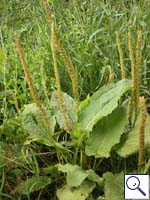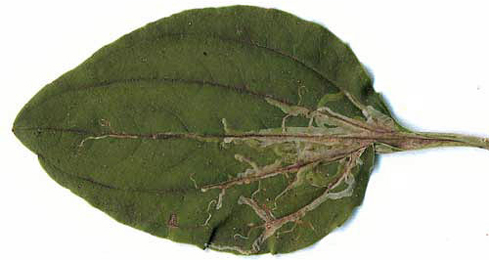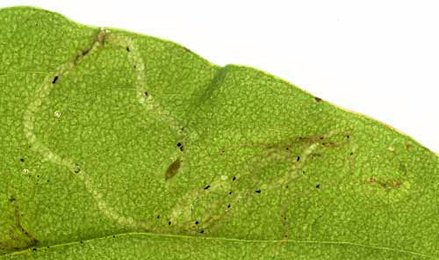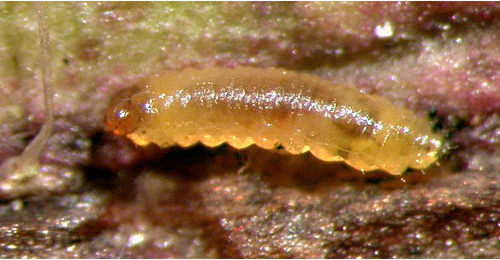|
||||||
|
PLANTAGO. Plantains. [Plantaginaceae] |
|
|
Twenty species of Plantago are recorded in Britain. These include the native Buck's-horn Plantain (P. coronopus), Ribwort Plantain (P. lanceolata), Greater Plantain (P. major), Sea Plantain (P. maritima) and Hoary Plantain (P. media) and the introduced Branched Plantain (P. arenaria). The BSBI provide a downloadable plant crib for Plantago major subspecies. Thirteen British miners are recorded on Plantago. A key to the European miners recorded on Plantago is provided in Bladmineerders van Europa. |
 Greater Plantain Plantago major |
Key for the identification of the known mines of British |
Note: Diptera larvae may live in a corridor mine, a corridor-blotch mine, or a blotch mine, but never in a case, a rolled or folded leaf, a tentiform mine or sandwiched between two more or less circular leaf sections in later instars. Pupation never in a cocoon. All mining Diptera larvae are leg-less maggots without a head capsule (see examples). They never have thoracic or abdominal legs. They do not have chewing mouthparts, although they do have a characteristic cephalo-pharyngeal skeleton (see examples), usually visible internally through the body wall. The larvae lie on their sides within the mine and use their pick-like mouthparts to feed on plant tissue. In some corridor miners frass may lie in two rows on alternate sides of the mine. In order to vacate the mine the fully grown larva cuts an exit slit, which is usually semi-circular (see Liriomyza huidobrensis video). The pupa is formed within the hardened last larval skin or puparium and as a result sheaths enclosing head appendages, wings and legs are not visible externally (see examples). See Key to non-Diptera. |
1a > Leaf-miner: A distinctive mine primarily above mid-rib, with irregular short lateral offshoots into leaf blade. Pupation external (Spencer, 1972: 51 (fig. 172), 55; Spencer, 1976: 270, 271 (fig. 486)). Branched, whitish, upper-surface corridor; main axis overlying the midrib; side branches overlying the main lateral veins. (In Campanula and Phyteuma the mine is much less branched, sometimes nothing more than a corridor on top of the midrib). Frass in rather long strings. Usually the mines begins as a long and narrow, shallow, tortuous lower-surface corridor that ends upon the midrib but otherwise is not associated with the leaf venation. Often this initial corridor is filled with callus, and then even less conspicuous. Pupation outside the mine. A linear mine on the upper surface, usually following the midrib and showing side branches along the veins. The frass is in strings. |
|
Liriomyza strigata (Meigen, 1830) [Diptera: Agromyzidae]. |
1b > Leaf-miner: Mine linear, whitish, both upper and lower surface. Pupation internal, at the end of the mine with the anterior spiracles projecting through the epidermis (Spencer, 1976: 433). Upper-surface, less often lower-surface corridor. Frass in isolated grains. Pupation within the mine, usually in a lower-surface puparial chamber. A long whitish upper surface corridor, which eventually goes lower surface. |
|
Chromatomyia horticola (Goureau, 1851) [Diptera: Agromyzidae]. |
1c > Leaf-miner: Mine initially lower surface, but largely on upper surface, irregularly linear, finally almost filling the petiole and ending at the base. Pupation within the petiole (Spencer, 1972b: 84, 85 (fig. 275A)). Several eggs are deposited on the blade. From there narrow corridors descend in the direction of the petiole. Once they have arrived there, the larvae start making broad lobate corridors that fan out over the basal half of the leaf. Later parts of the mine are party upper-surface, partly interparenchymatous, looking pale green. In the shallow parts primary feeding lines often visible. Frass in widely dispersed grains. According to Buhr (1964a) older mines often turn black. Pupation within the mine, often in the petiole. Puparium generally at the lower surface; the anterior spiracles penetrate the epidermis. |
 Mine of Phytomyza griffithsi on Plantago major Image: © Willem Ellis (Bladmineerders van Europa) |
|
Phytomyza griffithsi Spencer, 1963 [Diptera: Agromyzidae]. |
1d > Leaf-miner: A narrow, whitish linear mine, normally in the leaf but more rarely also in the stem. Pupation at end of mine, with the anterior spiracles projecting through the epidermis (Spencer, 1972b: 84). Strikingly narrow corridor, upper-surface or lower-surface, often also alternating. Frass in comparatively large, very widely spaced grains. Generally the corridor is so narrow that the frass grains seems to lay in a single row. Pupation within the mine, sometimes in the petiole. The black anterior spiracles of the puparium penetrate the epidermis. The mine is also illustrated in British Leafminers. |
 Mine of Phytomyza plantaginis on Plantago lanceolata Image: © Willem Ellis (Bladmineerders van Europa) |
|
Phytomyza plantaginis Robineau-Desvoidy, 1851 [Diptera: Agromyzidae]. |
1e > Leaf-miner: A short, irregular, linear upper surface mine on any part of the leaf. Also recorded from young pods (Bland, 1997a). Long corridor mine. As a rule the first part of the mine is lower-surface, the later part upper-surface. Often the loops are so dense that a secondary blotch is the result. Because upper- and lower-surface corridor segments often cross, the mine obtains a strange array of transparant patches. There is no association with the midrib. Frass in strings and thread fragments. Pupation outside the mine; exit slit in upper epidermis. Mine not associated with the veins or midrib of the leaf (It is this character which enables distinction from another Agromyzid pest species - Liriomyza huidobriensis). The larvae may leave one leaf (if not large enough) and enter another leaf, via the petiole). It exits the leaf to pupate through a semi-circular slit in the upper surface of the leaf. |
|
Liriomyza bryoniae (Kaltenbach, 1858) [Diptera: Agromyzidae]. |
1f > Leaf-miner: Full depth, initially a much branched corridor, irregular in width, in the end almost a blotch. The mine has openings by which part of the frass is ejected. The larvae frequently leave the mine to restart elsewhere. Older larva live free and cause window feeding, often erasing their old mines. In Coltsfoot also pseudo-mines are made, when the larva eats away the lower epidermis with the leaf tissue, but spares the dense hair cover. |
|
Phytosciara halterata Lengersdorf, 1926 [Diptera: Sciaridae]. |
|
Key for the identification of the known mines of British |
Note: The larvae of mining Coleoptera, Hymenoptera and Lepidoptera may live in a corridor mine, a corridor-blotch mine, a blotch mine, a case, a rolled or folded leaf, a tentiform mine or sandwiched between two more or less circular leaf sections in later instars. Larva may pupate in a silk cocoon. The larva may have six legs (although they may be reduced or absent), a head capsule and chewing mouthparts with opposable mandibles (see video of a gracillarid larva feeding). Larvae of Hymenoptera and Lepidoptera usually also have abdominal legs (see examples). Frass, if present, never in two rows. Unless feeding externally from within a case the larva usually vacates the mine by chewing an exit hole. Pupa with visible head appendages, wings and legs which lie in sheaths (see examples). |
| 1a > Leaf-miner: Rather long corridor winding through the leaf, regularly crossing itself. The corridor later widens considerably. Frass normally in a narrow central line, but may also lie along the side, or be absent. The larva regularly leaves a mine and restarts elsewhere. |
|
Apteropeda globosa (Illiger, 1794) [Coleoptera: Chrysomelidae]. |
1b > Leaf-miner: Rather long full depth corridor that winds freely through the leaf and may cross itself. In the end the corridor widens considerably. Frass mostly in a narrow central line, but may also be deposited along the sides or be missing. The larvae regular leave a mine to restart elsewhere. Pupation outside the mine. Neither larva or mine can be distinguished from that of related species. |
|
Apteropeda orbiculata (Marsham, 1802) [Coleoptera: Chrysomelidae]. |
1c > Leaf-miner: Early mine a silvery gallery in lower epidermis. Subsequently a blotch on the upper epidermis. Internal spinning causes the leaf to pucker and often fold over the blotch, concealing it. The mine starts as a long, tortuous, lower-surface (rarely upper-surface) epidermal, silvery corridor. After a moult the larva works itself to the upper surface of the leaf and begins to make a blotch, soon a tentiform mine, astride the midrib. The mine contracts very strongly, causing the epidermis to develop strong folds, and the leaf to double, almost concealing the mine. Shortly before pupation the larva gnaws a window in the floor of the mine, leaving only the lower epidermis intact, as a preformed exit opening. Larvae that have hibernated generally leave their mine, and make a new tentiform mine elsewhere. Pupa in a white fusiform cocoon in the mine. |
|
Aspilapteryx tringipennella (Zeller, 1839) [Lepidoptera: Gracillariidae]. |
1d > Leaf-miner: In the first instar the larva mines the leaves, forming short, irregular, blotch-like mines, but in later instars it lives externally, feeding in spun leaves and often twisting those of tender shoots. Larval head light-brown or yellowish brown, edged with black postero-laterally, ocellar area blackish; prothoracic plate black edged with whitish anteriorly; abdomen dull dark green; pinacula distinct, black, sometimes brownish but with black bases to setae; anal plate large, black (Bradley et al., 1973). Small, full depth mine without a definite shape; little frass. Some silk is deposited in the mine. The larva soon leaves the mine and continues feeding among spun leaves. |
|
Cnephasia incertana (Treitschke, 1835) [Lepidoptera: Tortricidae]. |
1e > Leaf-miner: The mine begins in the midrib, especially in a lower leaf, extending into the leaf disc, branching irregularly or pinnately, may also locally be blotch like. The mine is brown and very transparent. Sides very irregularly eaten out. Frass loosely dispersed or in a loose central line, buy may also be pressed against the sides of the corridor. The larva may also leave the mine and restart elsewhere. |
 Orthochaetes setiger larva, dorsal Image: © Jean-Yves Baugnée (Bladmineerders van Europa) |
|
Orthochaetes setiger (Beck, 1817) [Coleoptera: Curculionidae]. |
|
1f > Leaf-miner: Larvae in blotch-like mines. Most frass is ejected through a small opening in the mine. Fresh mines are very difficult to find. The larvae can leave their mine and restart elsewhere. Pupation external in a mud-covered cocoon on the ground. |
|
Scrobipalpa instabilella (Douglas, 1846) [Lepidoptera: Gelechiidae]. |
1g > Leaf-miner: Feeding is in leaf blotches, spun shoots and roots. Wilting greyish leaves, or frass in the crown of the plant may indicate a larva in the roots. Young larvar make a short, very narrow gallery in the young leaves. Later they bore in the rhizome. |
|
Scrobipalpa samadensis (Pfaffenzeller, 1870) [Lepidoptera: Gelechiidae]. |
| Last updated 06-Jul-2019 Brian Pitkin | ||
.
